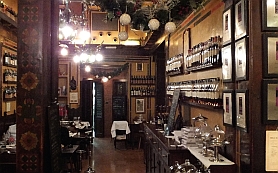If the health inspectors of Verona will permit, I would like my ashes scattered on the floor of the Antica Bottega del Vino — the best wine bar in the world. Forget Juliet's balcony, with all its lovelorn graffiti, and head to this gem tucked away on a tiny alley called Via Scudo di Francia just off the Piazza del Erbe. It's a place of pilgrimage for the true lover of wine.
Established in 1890, the Bottega's wine collection is one of the best in Italy, with 18,000 bottles in the rabbit warren of cellars that nestle into a Roman wall. The Bottega's list is 165 pages of the finest producers from Italy and around the world. There is a huge chest of drawers down there filled with vintages of Q uintarelli Amarones and Domaine de la Romanée-Conti. You want Château Pétrus, Grange, Krug and Yquem? It's all there, but the pride of the collection are the wines from the Italian provinces, and particularly the range of local Amarones.
When I first visited the Bottega in the mid-1980s, the owner would stand at the bar and announce winemakers when they entered as if they were visiting movie stars:
“Angelo Gaja! … Giorgio Grai! … Giacomo Bologna!”
And we would repair down to the cellar and pull bottles from the racks to have with steaming plates of pasta. Those days, sad to say, are long gone, but the menu offerings at the Bottega are still great, the snacks at the bar are still delicious, and the number of wines available by the glass is enormous.
> The first Italian wine I ever purchased was in London in 1966. It was the Masi Campofiorin 1964, the original vintage of a wine that would introduce the world to the concept of ripasso. This time-honoured process was used by the peasant farmers of Veneto to add body and structure to their Valpolicella. The newly made wine was re-fermented on the lees (the dead yeast cells, grapes skins and seeds) of their Amarone production.
The grapes for Amarone need to be dried for up to 120 days on racks before they can be fermented to concentrate their sugars. Sandro Boscaini, the current owner of Masi (a.k.a., Mr. Amarone) refined and modernized the technique by adding partially dried grapes to his young Valpolicella.
Boscaini registered the name Ripasso to refer to this method but ultimately donated the trade-mark to the Verona Chamber of Commerce. Now virtually all the 70-plus Amarone producers in the region make a Ripasso wine. Masi produces five different Amarones and was the first producer to make single-vineyard Amarones, each with a recognizable terroir character.
> If a noble Tuscan family like the Frescobaldis can survive for 32 generations, there are bound to be some black sheep lurking under the family tree. And being a wine family, the Frescobaldis might just have their exploits memorialized in wine. The family's Q uaranta Altari (“Forty Churches”) Vin Santo recalls the penance of an early 18th century ancestor named Bartolomeo Frescobaldi.
This sociable marchese held a Ballo Angelico – a pagan rite where the participants dance naked – at his Villa di Montecastello in Tuscany. Gossip about the party reached Rome, and Bartolomeo was summarily excommunicated by Pope Clement XI. Determined to get back into the Church, the chastened Bartolomeo made the journey to Rome on foot to beg forgiveness. The Pope finally exonerated him when he promised to build 40 churches around the Val de Pesa area in the Province of Florence. Interesting that the commemorative wine should be a Vin Santo — Italy's “holy wine.”
The contemporary Marchesi de' Frescobaldi have another fascinating connection with miscreants. Between Corsica and Livorno is a small island called Gorgona that could be called Italy's Alcatraz.
The monastery on the island, which dates back to the Middle Ages, was appropriated in 1869 and turned into what today is euphemistically called an “agricultural penal colony.” The inmates make cheese and, under the supervision of Frescobaldi winemakers, a wine called Gorgona, which is a blend of Ansonica and Vermentino grapes. The first vintage of Gorgona was 2012 and proceeds from the sale of the small production support the rehabilitation efforts for members of the colony.
> If you're talking about Castello di Volpaia in Tuscany, you might say it takes a hamlet to raise a winery. You wouldn't know that wine was produced here because the fermenting and aging cellars, the barrel rooms and bottling plant are hidden inside churches, houses and in subterranean passages all connected by pipes under the cobbled streets.
The same goes for the press house for Castello di Volpaia olive oil. This 12th-century fortified village, set on one of the highest hills in Tuscany, looks like a sleepy place well off the usual tourist route. But Giovanella Stenti and her family, who own the village – literally lock, stock and barrel – run a thriving business, employing directly or indirectly the 60-odd inhabitants of Volpaia. They also run a wine bar and a delightful open-air restaurant.
> And that, gentle reader, is how I spent my summer holidays. Ciao.
Tony Aspler is the author of 17 books on wine, including his latest, Canadian Wineries.





